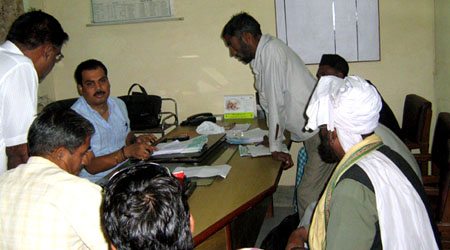
In this section we provide an overview of some of the issues, both past and present, faced by the Van Gujjars in order to continue their livelihoods.
Primary challenges to the Van Gujjars’ sustainable forest practices hinge upon their limited legal claims to the forests and the states' Forest Departments’ perception of the community.
The Van Gujjars’ restricted legal claims to the forests manifest in the form of forest permits. Issued bi-annually by the Forest Departments, the permits confine the Van Gujjars to limited areas and stipulate the number of buffalo allowed within the forest. The permits have not been updated since 1937 and are held by individual families. To survive, these families’ herd sizes must be larger than allowed, whilst remaining within their minimal area of forest. The increased number of buffalo and people within permit areas intensifies pressure on the environment and decreases the availability of buffalo fodder. Moreover, exceeding the permits affords forest officials the power to exploit the community by demanding heavy dairy and monetary bribes for their use of and access to the forest.


The Forest Departments seek to conserve the Himalayan forests as ‘natural’ eco-systems; in this light, the Van Gujjars and their livestock are perceived as a threat to the environment. The Forest Departments frequently either bar the Van Gujjars from national parks or bribe them for their entry and use of the forests. The Forest Departments coerce the community into surrendering their permits for conserved forests in exchange for the inadequate and informal ownership of property in specially constructed settlements. Outside of conserved areas, the Forest Departments heavily control the Van Gujjars’ use of the forests and employ regulations as a means to lever bribes. Additionally, their destruction of the Van Gujjars’ huts and taxations on their use of materials to re-build them further alienates the community from the forests. Additionally, the people have to contend with the deterioration of the forests due to the increased use by illegal loggers and villagers.
The Van Gujjars’ practice of transhumance is essential to the survival of their herds and the rejuvenation of the forests. The month long walk either up or down the Himalayas has always been hazardous to both people and buffalo. However, this practice has become increasingly dangerous due to the heightened volume of traffic where the Van Gujjars use the roads.
Additionally, forest officials may barricade the routes, only permitting entry upon dairy or monetary payments. Currently, several family members abstain from transhumance, opting to safeguard their huts, grasses and fodder trees in the lowlands instead.

One facet of the Van Gujjars’ livelihoods concerns the sale of buffalo milk. In the recent past, middlemen heavily exploited the Van Gujjars, providing pittance for their products. As the price of milk was insufficient for survival, the middlemen were able to offer loans with high interest rates, pushing the Van Gujjars further into poverty.
However, SOPHIA’s market intervention, through the Milk Marketing project, stimulated the price of milk to rapidly increase. Whilst the sale of milk is no longer an issue, the reduction of available fodder has meant a decrease in the quality of milk and an increase in the susceptibility of the herds to infections and diseases.

As nomadic people, the Van Gujjars generally occupy a state for the maximum of six-months and are without an address. In the past, the states the community inhabits denied them citizenship and their domicile rights. Due to their position as a non-voting cohort, the community’s needs were unimportant to politicians. Furthermore, the lack of citizenship inhibited the Van Gujjars’ access to social welfare.
During the last decade, through SOPHIA’s support, the Van Gujjars have asserted their citizenship, becoming politically engaged and accessing numerous welfare services. However, the state’s provision of education to the Van Gujjars is largely outstanding. The Van Gujjars’ illiteracy makes them vulnerable to exploitation, as it inhibits their access to information and problematises their verification of written texts.
